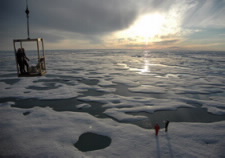UNH/NOAA Report: Arctic Region Unprepared for Maritime Accidents
The existing infrastructure for responding to maritime accidents in the Arctic is limited and more needs to be done to enhance emergency response capacity as Arctic sea ice declines and ship traffic in the region increases, according to new report released by the University of New Hampshire and the Commerce Department’s National Oceanic and Atmospheric Administration (NOAA). (More)





